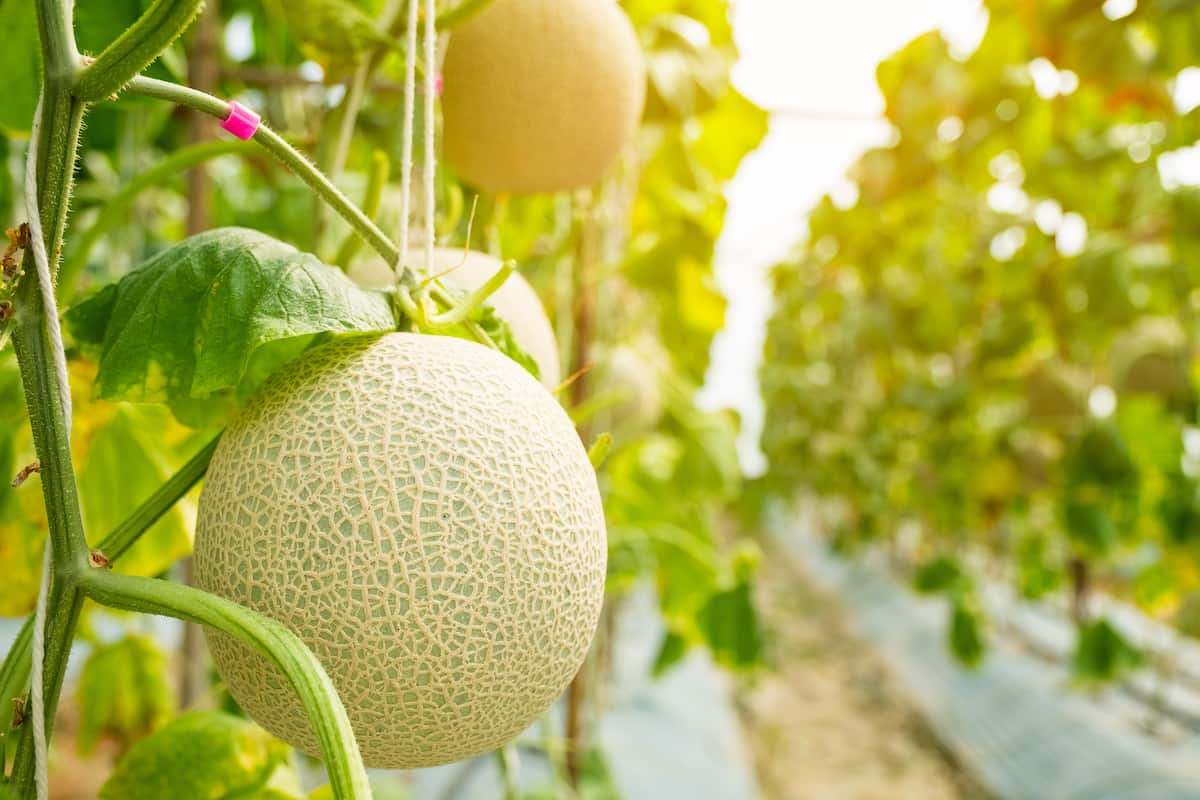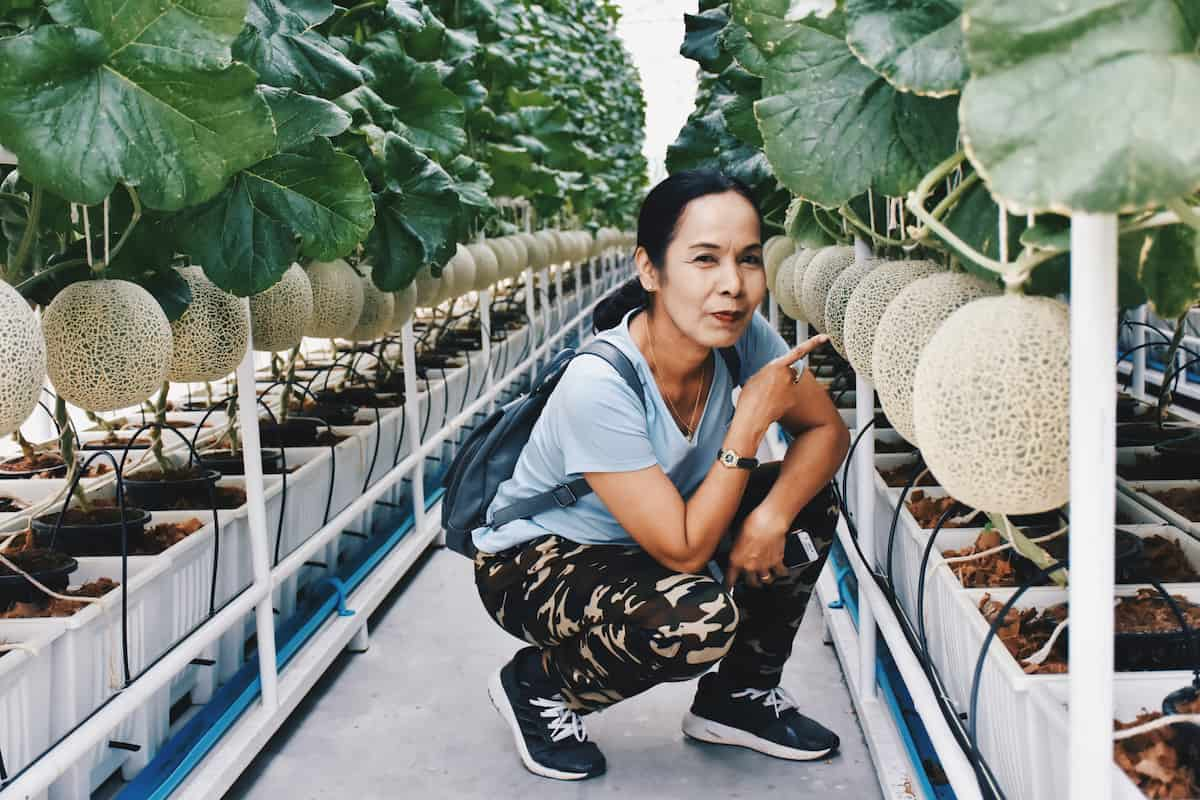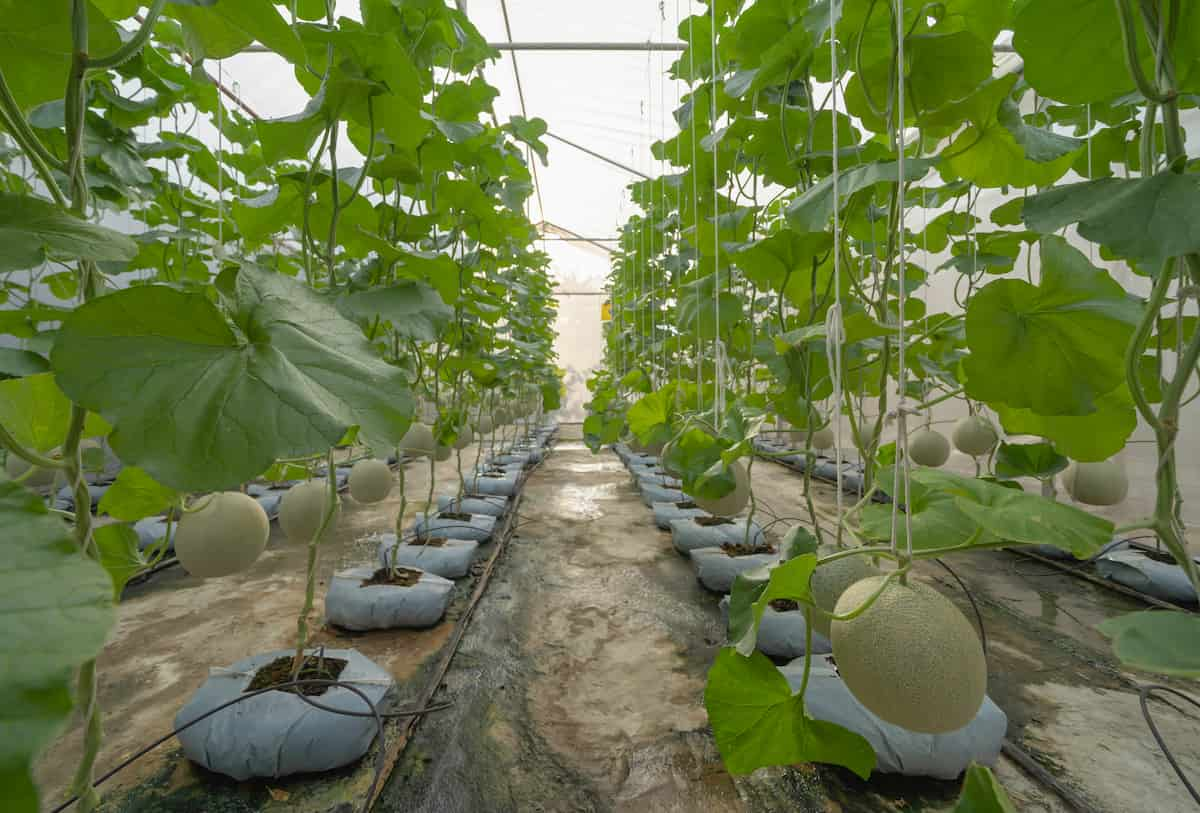Summer months are the season for growing Muskmelon, an important fruit vegetable. This dessert fruit’s sweet, pleasant taste and thirst-quenching properties make it a popular choice among dessert lovers. Muskmelon is harvested in May-June after seed sowing from the end of February to the second week of March. For off-season production, however, the crop can be grown under low-cost greenhouses or polyhouses. Off-season cultivation of Muskmelon can be done in low-cost, naturally ventilated greenhouses.

How to Grow Muskmelon/Cantaloupe in Greenhouse
Climate and Soil Requirement for Greenhouse Muskmelon Cultivation
Muskmelon can be grown in hot and dry climates because it is drought-resistant. Frost and low temperatures are harmful to plants. Foliar diseases may be more likely to develop in humid climates. Fruit quality may be compromised by excess moisture and high humidity during fruit maturation. Temperatures between 28 and 30°C are ideal for plant growth.
During the ripening period, low humidity and high day temperatures with enough sunlight are conducive to the development of flavor and total soluble solids (TSS) in fruits. Foliar diseases can also be reduced under these conditions. Muskmelon grows best in sandy loam soil with good drainage. It prefers a pH of 6.0 to 7.0 and is slightly tolerant of soil acidity.
How to Sow Muskmelon Seeds
Sow your melon seeds in March and April if you grow them in a greenhouse. You should wait until April or May if you are growing them outdoors, so they will be ready when the weather gets warm. Set each seed 0.5 in (1.25cm) deep in a small pot of seed compost in a heated propagator or greenhouse at a steady temperature of 21-24 °C.
After the seed germinates, wait until the plant has produced its first pair of ‘true’ leaves (which enable photosynthesis). Once this is accomplished, the plants are ready to be moved to a sunny location or placed in a greenhouse, cold frame, or cloche. Three feet of space should be provided for each plant.
Planting and Growing Muskmelon in a Greenhouse
Muskmelon is usually planted in November-December for off-season harvesting under greenhouse conditions. The seedlings are first raised in pro-trays or polyethylene bags under protected conditions. Using pro-trays, the nursery grows in soilless media. It takes 28-32 days for the nursery to be ready for transplanting. A row of Muskmelon is planted on each greenhouse bed at a spacing of 30 cm.
Training and Pruning of Muskmelon Plants
The main stem of Muskmelon plants is trained upwards to climb to the overhead wires along with polyethylene twines. Plants are trellised vertically on the twine, anchored loosely to the stem’s base with a non-slip noose. After the plant reaches the horizontal support wires, it can be trained along with the steel wire (running along the rows at 8-9 feet) and then trained downward.
In case you missed it: How to Grow Yellow Muskmelon from Seed: A Step-By-Step Guide

Once the branches reach 45-60 cm above the bed surface, they are pruned only after forming one or two fruit buds (female flowers), which will bear the fruit. The plants are carefully trellised on the main stem and side branches without damaging them.
Irrigation Requirements for Growing Muskmelon in Greenhouses
Melons will be successful or unsuccessful according to how they are watered. It is important that the water reaches the roots deeply but does not oversaturate or drown them. Melons can split if they are too wet, so keep them moist but not wet. An Access drip watering system is ideal for ensuring water reaches the roots.
Install a pipe to pour water directly into the soil surrounding the roots of fruit if your greenhouse is on the soil. Submerge a plant pot next to the fruit or submerge a plant pot next to the fruit if the greenhouse is on the soil. Once the fruit has begun to appear, you should use liquid tomato fertilizer once a week to feed your plant.
Fertigation in Muskmelon
Muskmelon crops are mostly cultivated under greenhouse conditions using drip irrigation systems. Irrigation water is used to apply fertilizers. Depending on the season and stage of the crop, fertigation quantity and duration will vary. It is also important to consider fertilization when determining muskmelon fruit quality. The fertigation is done at 12-14 days during December-January, and 3.0 m3 of water will be applied to each 1000 m3 area through each irrigation.
6.0 liters of fertilizer solution (5: 3: 6) per m3 of water should be applied through irrigation. In March and April, irrigation intervals are reduced to eight and six days, respectively. After the fruit set, the fertilizer solution is reduced to 1.0 liter per m3 of water and continues until the fruits reach lemon size. Afterward, 3.0 liters of fertilizer solution are applied per m3 of water.
Muskmelon Plant Protection
Fusarium wilt is one of the destructive fungal diseases. Growing resistant varieties is the best way to control Fusarium. Spraying fungicides like karathane or mancozeb at 1.0 and 2.0 grams per liter of water can control powdery and downy mildew diseases. Under greenhouse conditions, mites also cause severe problems for growing Muskmelon. A timely spray of miticides, such as dicofol at 2.0 ml per liter of water, can control the mites, but repeated sprays are necessary for effective control. It is important not to spray any pesticide when bees are active when spraying pesticides.
When Should You Harvest Your Muskmelon?
Fruits on an individual plant tend to ripen somewhat concurrently within a short period. Likely, the others on the plant will soon follow after the first melon is harvested. In most melon varieties, the rind changes from green or gray to yellow when it matures. When the stem is ripe, it can be easily removed from the vine by hand. Depending on the variety, melon varieties can display slightly different cues once they are ready for harvest.
The stem of a Muskmelon or Cantaloupe should easily and cleanly pull off the fruit when the fruit is ripe. A melon is not fully mature if the stem has to be removed forcibly. Muskmelons that are mature have a musky aroma, as well as a slightly soft end opposite the stem. When honeydew is ripe, it will not slip off the stem. Honeydew melons should be harvested when the skin becomes creamy yellow, and the end opposite the stem softens.
In case you missed it: How to Grow Bitter Melon/Gourd in Greenhouse: A Step-by-Step Guide for Seed to Harvest

Conclusion
Melons can be the star of your greenhouse. They are not the usual fare, and the rush of pleasure you will feel when stepping into your greenhouse and seeing them there will be worth it every time. They are great on the table, too, allowing your home-grown food products to expand from fruit salads and fruity garnishes to those late-summer cool drinks in the shade.
- Feed Your Flock for Less: Top 10 Tips to Save on Chicken Feed
- Ultimate Guide to Ossabaw Island Hog: Breeding, Raising, Diet, and Care
- Hatching Answers: The Top 10 Reasons Your Chickens Aren’t Laying Eggs
- Eggs and Economics: Breaking Down the Cost of Raising Backyard Chickens
- Defend Your Greens: Proven Methods to Keep Iguanas Out of Your Garden
- Ultimate Guide to Cinnamon Queen Chicken: A Comprehensive Guide for Beginners
- Ultimate Guide to California Tan Chicken: Breeding, Raising, Diet, Egg-Production and Care
- Ultimate Guide to Marsh Daisy Chicken: Breeding, Raising, Diet, and Care
- 10 Types of Chicken Farming Businesses You Can Start for Profits